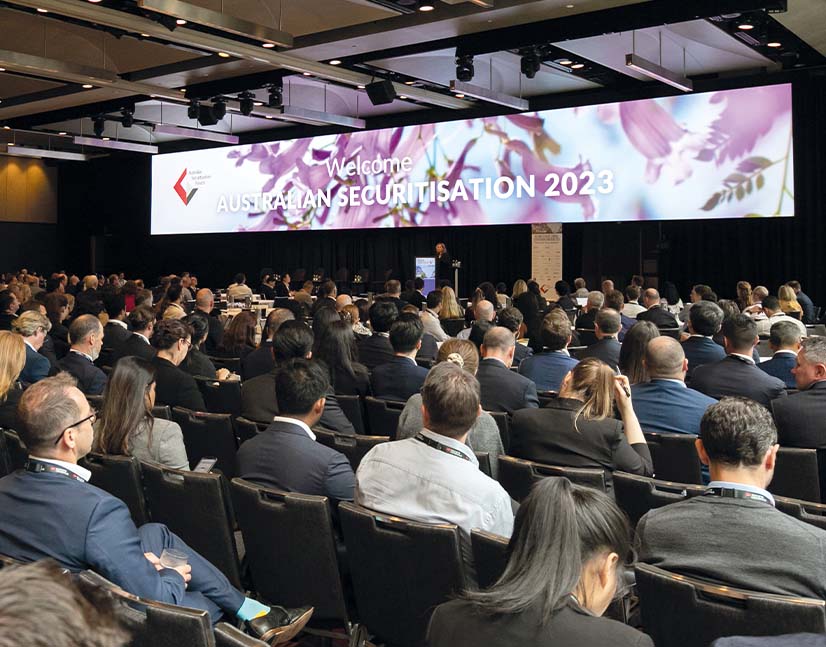
Where to focus, what to do: the next steps for sustainable finance
To close the 2023 KangaNews Sustainable Debt Summit, market leaders from Australia and offshore came together to discuss the areas in most need of focus from the sustainable finance industry in the months and years ahead. The sector is diversifying fast and needs to keep building infrastructure to support current and future growth.
DISCLOSURE AND AMBITION
Timbs How might the type of disclosure required in mandatory risk reporting change the sustainability market?
PLAISANT MILLECAMPS Mandatory risk reporting will be very useful – we hope it will help companies uncover opportunities in sustainable finance. Companies will not need to start from scratch: they will have some guidance and metrics, and be able to leverage these to pursue labelled issuance.
Mandatory reporting will also bring more clarity to issuers, including via benchmarking. One of the biggest issues for investors and banks is comparing one company with another, and this tool will make that easier. It will still need to be taken with a grain of salt – there will be sector-specific metrics and companies may differ even within the same sector – but it is a starting point.
There is also risk around the interoperability of all these standards. A small sustainability team may see the wave of reporting standards and become overwhelmed, and a sustainable debt or sustainable finance framework could add to their workload on top of mandatory disclosure. We need to consider this risk, to make sure mandatory risk reporting and sustainable finance operate together.
Sustainability teams are made up of people of action who are passionate and want to drive change. If we bury them under reporting, they might become distracted from what matters.
Timbs How can we bring transition into the sustainable finance tent in a way that is rigorous and impactful?
WEST One of the great challenges we are dealing with in North America, as I know Australia is too, is transition – and how to do it credibly. Investors and underwriters want to see a pathway to credibility in transition instruments, but we have not yet seen much growth in the transition labelled bond market.
We have seen sustainability-linked debt come into the vernacular because, frankly, it was the path of least resistance for many companies that are in transitional categories or doing transitional activities to access the market. But developing standardisation on what is credible and rigorous will help combat burgeoning concern about greenwashing and greenhushing. This will help accelerate capital to carbon-intensive industries that need it – in a way that is defensible.
I believe this is where sustainable finance will play a role. This is not to say sustainability-linked instruments won’t continue to be important and impactful, though – I believe the two can coexist.
If we do transition finance the right way, it can create huge opportunities to unlock capital. But we need investors to agree – and reporting comes into it, too. We need to be able to move past judging something as acceptable now and for all time, to saying something is acceptable as best practice currently while leaving space for future enhancement.
Timbs Does there need to be enhanced market structure for transition instruments?
LANYON Yes there does. Climate Bonds Initiative has done a lot of good work in the space and the work ASFI [Australian Sustainable Finance Institute] is doing is also really pleasing, but we still don’t have agreed principles across the market.
ASFI is exploring a ‘traffic light’ approach that will incorporate transition. This will allow activities that are on the pathway to transition to be included. However, the key to using the transition label more will be for all these standards to be developed in tandem.
Timbs Do we have the right instruments to get capital flowing in a way that maximises impact in complicated areas?
LANYON With the exception of last year, growth in the sustainable finance issuance market over the last few years is indicative of success in driving capital toward positive outcomes.
Green still dominates: more than 50 per cent of the bond market on a global basis is still tailored toward green. But the Australian market is a lot more diversified, with a more even mix across green, social and sustainability. This indicates that we are looking at more issues than purely environmental, which is really pleasing.
There has been a similar theme in the loan market. Last year, we witnessed the first social use-of-proceeds loans. There are also more social KPIs being used in sustainability-linked loans (SLLs), including some tailored toward social outcomes such as Indigenous employment and gender diversity.
In this context, it is increasingly important that we ensure standards are maintained – so the market can continue to adapt and allow for innovation.
WEST I completely agree about the importance of credibility. Ideally, we will get to the point where credibility is so clear that we work ourselves out of a job.
We also need more products and services aligned with sustainable finance targets. There is a lot more we can do here, whether it is ESG [environmental, social and governance] derivatives, green repo or letters of credit for clients that are doing ESG initiatives in auctions for carbon.
All of us default to thinking about bonds and loans because they are huge parts of the market. But some of the most interesting innovations are happening at the margins. The question is how we take any specific area of the market and credibly incorporate ESG into it. It would be great to be able to provide a client with an entire product suite with an ESG lens, if they so desire.
An important point here is that any individual product in isolation may not be that interesting: a 5-10 basis point discount is not much, especially with rising rates. It becomes much more compelling if we are talking about a total market approach – this is when it becomes interesting.
The role of carbon offsetting in delivering net zero commitments
Australia’s carbon market is set for growth on the back of an expanded political commitment to the safeguard mechanism that requires major polluters to offset their emissions. Other companies are already offsetting on a voluntary basis. The appropriate scope and role of carbon offsetting is still up for debate, though.
LANYON Offsets will play a role alongside reducing emissions. To reduce emissions, it is really important that we understand our clients’ decarbonisation strategies in totality. We need to ask how we can support them with capital and solutions throughout their entire journey. This could mean greening electricity supply, replacing machinery and electrifying as much as possible.
Sustainable finance plays a role too, through use-of-proceeds and sustainability-linked instruments. Almost every sustainability-linked transaction we have been on has had an emissions reduction target.
Nonetheless, offsets are a valuable component of emissions reduction strategies, and facilitating supply and demand will be critical. Voluntary targets and decarbonisation strategies will drive growth in demand, as well as the proposed changes to the safeguard mechanism.
PLAISANT MILLECAMPS We all have tools in the toolbox and I do not think we need another label. There is already plenty to work with. It is a question of incorporating the carrot and the stick. For example, in the loan market, we have ‘carrots’ – as in, stretch targets that offer a small discount. Tax incentives, such as the EU Green Deal and the US Inflation Reduction Act, act in a similar way by encouraging companies and investors to look at new technologies. On the other hand, the ‘stick’ is tools such as the penalty associated with SLBs [sustainability-linked bonds], policy like the safeguard mechanism, or regulation like ASIC [Australian Securities and Investments Commission]’s work to call out greenwashing.
THOMPSON I agree that we have the right structures and the right instruments to help advance sustainability objectives. But to really grow adoption, we also need mandatory disclosure and underlying infrastructure such as taxonomies.
Once this is in place, we also need to strike the right balance between not being overly prescriptive while being able to provide consistency, comparability and high-quality underlying data to support the issuance of sustainable debt instruments going forward. We must get this right to preserve the integrity of the market and to allow issuers, of all types, the ability to access sustainable finance.
INSTRUMENT TARGETS
Timbs On disclosure and targets, is there sufficient ambition from issuers in the targets that are being set up? How important is it that markets keeps pushing the boundaries?
PLAISANT MILLECAMPS I think failure is, and should be, a possibility – in fact, it brings more credibility to structures. We see this in the loan space, where typically two to four KPIs are set and tested every year. In the early stages, the expectation is that the companies will fail some of these targets in any given year. If they succeed in meeting all of them every year, it means the targets might not be ambitious enough.
We are just testing the first SLBs now and we are seeing the first issuers to fail on their targets this year. We need to see how investors will react to this. They are priced to continue to be invested in instruments that continue engaging and drive change. I believe failure is something we need to accept.
THOMPSON I agree, but there needs to be some give and take. What is in it for the issuer if there is a punitive structure on a bond and the target is so ambitious that they are unlikely to be able to achieve it? Why do it? This is not to suggest that success should be a slam dunk by any means, but it is important to remember that the two-way incentive structure is why SLLs have been so popular.
WEST This is where we need investors – because the bottom line is that we are not seeing incredibly ambitious targets from companies. Everyone knows how this works: we search for what we think we can achieve, work out the margin of safety beneath it – and this is what gets published. This is what every single corporate does. It is the nature of the business.
What is interesting is that they are doing this even though, based on statistical analysis, we are not seeing a correlation between performance in the equity market and missing targets. We want to see sharper KPIs and it does not seem to be too costly to offer them. So what incentive can we offer?
I loved seeing Uruguay enter the sovereign debt market with a two-way structure this year. I do not think we will see symmetrical coupons, though – because they cannot happen under current rates. However, we could see asymmetrical steps for clients that have ambitious targets.
After this, it would be up to investors to help underwriters push in the right direction. We are all trying to get to a credible, efficient market but this is where we need capital providers to really step up and assist. At the end of the day, they are the ones that are going to be investing.
TONKIN Due to the level of ambition of companies, treasurers and CFOs, as well as their concern over whether they could risk missing their targets, I believe the market has moved on from a point where the penalty is the issue for borrowers. A very big concern for borrowers, rightly or wrongly, is their reputation associated with missing a particular target. They need to hear from their investors that they want to see more ambitious targets coming into play rather than the message that there is big reputational risk.
There is a fear of setting targets that are too ambitious – that are perceived to be almost unattainable. The new Sustainability Linked Loan Principles remove a lot of the middle ground between the discount and penalty – or at least it has been encouraged to go away. Regardless, the reality is that CFOs and treasurers are concerned about missing targets and this feeds into some of the more challenging discussions we have when we are setting ambitious targets.
Adding biodiversity
The sustainable finance market is waking up to the critical nature of biodiversity protection. It is a complex issue, however, and the time to act is short.
TONKIN According to the World Economic Forum, more than 50 per cent of the world's GDP is moderately or highly reliant on biodiversity. A walk down the street demonstrates the sort of goods and services that rely on biodiversity: medicines, fruit and vegetables, wine, clothes – what happens to businesses like these? I believe we do not have time to think about whether we are ready: we need to take action.
COP27 at the end of last year made some significant pledges about biodiversity and set targets for 2030. Biodiversity is unfolding faster than the emissions conversation happened and is very complicated, so businesses need to engage.
TONKIN Investors will drive a lot of the biodiversity and natural capital discussion. They need to think about the risk of their investments into companies where there is no biodiversity risk mitigation or even awareness of what the risks are.
THOMPSON We can build on the infrastructure that has already been developed for climate. We cannot solve climate without solving nature, and vice versa. It has taken a long time, but we have made tremendous progress and now have a framework for reporting on climate-related risk and opportunity – and a similar framework is being developed for nature.
Additionally, entities like the International Sustainability Standards Board are seeking to incorporate the developments of the TNFD [Taskforce on Nature-related Financial Disclosures] into sustainability disclosures.
Continuing to build on this infrastructure will help us move quickly – and disclosure will be key in this respect. It is as much about the ‘how’ as it is about the metrics we report on.
Speaking of metrics, there has already been progress in the sustainable debt market. Last year, the International Capital Market Association published a KPI registry for use-of-proceeds and sustainability-linked bonds, more than 40 of which relate to nature and biodiversity. What this means is that there is now a suite of metrics we can use to align issuers’ cost of capital and performance against financing targets.
Audience question How do banks deal with the tension of continuing to participate in syndicated loans to a borrower in the event that the lender is no longer satisfied that the borrower’s targets are ambitious?
THOMPSON We would look at it as an opportunity to engage. It is not an easy situation to be in, but it is an opportunity to have a conversation with the borrower: to understand what the rationale was for the particular structure, to get more information and ask questions on the context.
In return we would talk about what we believe aligns with best practice and how to mitigate against reputational risk, by coming up with structures that would be regarded as credible. Hopefully, through constructive dialogue, we would reach a place where we can improve the structure by providing perspectives and advice.
TONKIN It is worth bearing in mind that almost all facilities require lender consent, unless it is a sleeper SLL that has been enacted by majority lender consent. If a lending bank is unsatisfied with targets, there is an opportunity to engage or an option not to participate if it reaches that point.
Decisions like these come down to the conversation lenders have – the engagement – particularly for loans, because they have a lot more flexibility than a bond. Once other lenders have come in and stated that they think something is not ambitious enough it is not totally unknown to go back and reset some targets.
While this does not happen very often, it is important to convey how important it is to be willing to go back and engage. Again, it comes back to the conversation about investors telling the borrower that it needs to be ambitious. This means banks in the SLL space but we would like to hear from bond investors as well.
Audience question Should companies and investors factor ESG impacts into how they assess divestment? An example is BHP’s oil sell-off at the peak of the oil cycle, that brought a windfall for shareholders – even those with ESG mandates.
WEST I’m not an investor, but I think the way the market is evolving is that any transaction in financing, particularly M&A, needs to account for all the impacts – not just the economic or corporate ones.
Impact is going to be a very real conversation. We are seeing it play out in Europe right now with the European taxonomy, with SFDR [sustainable finance disclosure regulation] and with how we are starting to attempt to measure, through reporting, what companies are doing. I believe impact must be standardised to some degree because one of the challenges is that we are all reporting it differently.
It has been an interesting year for fossil fuels. If you favour a divestment approach, this has not been your year. But the reality is that we cannot look at things on a one-year basis. Investors should consider transition to be a multiyear challenge and solutions must be supportive of this.
We are hearing from a lot of asset managers with ESG mandates that they want these mandates to work on a multiyear basis. This is because there is a disconnect on the asset management side: mandates are one-year and performance-based, yet investors are being told to factor in long-term ESG factors.
I don’t think it is possible to take one year in isolation and say a specific sale should not have been made or it was a windfall for the seller. Rather, I would ask: what does it look like in the longer term? Shell, for instance, has net zero ambitions – how does it get there? How do we factor in what a transaction really means for Shell’s financed emissions?
TONKIN I don’t want to put words in investors’ mouths but I have heard several speak about staying engaged for the longer term, using this as an opportunity to keep their capital in play so they can continue to have dialogue. I believe this is an interesting and important point to make, and we are seeing it play out.
On the flip side, access to capital is key and is likely why everyone in this room is here. Being able to demonstrate sustainability credentials is also a ticket to additional capital and, hopefully, a better cost of capital. I suspect we are still somewhat marrying these two sides of the equation.
FEAR FACTORS AND OUTLOOK
Timbs What are you worried about that we are not yet tackling properly – and what will we be talking about this time next year?
WEST I think disclosure, and implementation of disclosure, is going to be a massive topic. We are expecting our market – first in the US with Canada expected to follow – to see disclosure, for the first time, of environmental metrics. This will be announced in April followed by a phase-in period.
We are expecting the exclusion of scope-three emissions initially, but then for scope-three likely to be tabled in the next 12 months – before the next US election. Once the SEC [Securities and Exchange Commission] does this, I think it is going to be a huge talking point next year.
PLAISANT MILLECAMPS Next year I hope to talk about two things. The first is more discussion about the circular economy and how we can consider transition and adaptation investments.
Second – and this is perhaps more left field – how can we think differently to incorporate wellbeing indicators and not just GDP as the indication of success and growth? We still talk a lot about GDP growth without including the social element, the social impact or social value creation. I hope this starts to change in the next year.
THOMPSON I have been saying this for a few years now, but I hope that next year we will be talking about the take-off of the transition finance market – whether it is labelled transition instruments or just an advancement of the transition theme in existing instruments such as green, sustainability or sustainability-linked.
We cannot wait. So much time has been spent trying to define what is and is not eligible for transition and we have lost precious time in the process. Meanwhile, we continue to focus on the darkest green opportunities – because they are the most credible ones.
This is not to say we want to encourage a wild west outcome, but I believe we are at a tipping point. Amy and I are involved in an effort in Canada to develop a transition finance taxonomy. I really hope this can be helpful to the market by providing some consistency as well as comfort to investors, banks, underwriters and issuers alike on what is and what is not acceptable. Then we can start to see capital directed to some of these opportunities.
LANYON It is easy to focus solely on issuance numbers, but what I would like to see is an increasing focus on the impact instruments are having. For example, is there a way the industry can aggregate the various emissions targets within SLBs to gauge what impact they are having?
A lot of questions we receive are from investors that want to see impact reporting. In this context, we ought to think about how we can enhance reporting to really go beyond the numbers, to demonstrate the actual impact we are having on a on a broader scale.
TONKIN I agree with all the points that have been made here. As well as all of these I would add the importance of incorporating biodiversity, natural capital and maybe a bit of natural capital accounting.

WOMEN IN CAPITAL MARKETS Yearbook 2023
KangaNews's annual yearbook amplifying female voices in the Australian capital market.

SSA Yearbook 2023
The annual guide to the world's most significant supranational, sovereign and agency sector issuers.














